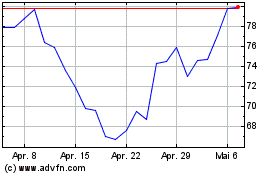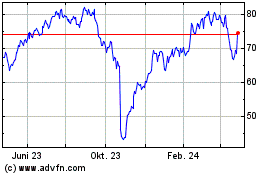Canadian Digital Fraudsters Increasingly Target Insurance Industry in First Half of 2022
22 September 2022 - 12:00PM

According to a TransUnion Canada TruValidate study, for the second
consecutive quarter, the rate of suspected global digital fraud
attempts in the insurance industry experienced the greatest rise on
a year-over-year basis, increasing 159% between Q2 2021 and Q2 2022
(+125% originating from Canada). This follows a 134% global
increase between Q1 2021 and Q1 2022 (+151% originating from
Canada). Despite this rise in suspected fraud against the insurance
industry, TransUnion’s (NYSE:TRU) quarterly fraud analysis observed
that the overall rate of suspected digital fraud attempts across
industries globally declined by approximately -14% between Q2 2021
and Q2 2022. In Canada, suspected digital fraud attempts decreased
-37% in the same timeframe.
TransUnion observed declines in the rate of suspected digital
fraud attempts from Canada-based transactions across a number of
industries including: gaming (-66%), financial services (-52%),
retail (-31%), telecommunications (-13%), travel and leisure (-6%)
and logistics (-3%).
Conversely, the only industries beyond insurance that
experienced increases in suspected digital fraud attempts
originating from Canada year-over-year in Q2 2022 included
communities such as online dating, forums, etc. (+10%) and gambling
(+8%). However, the types of fraud each of these three industries
experienced were very different. First-party application fraud was
the top insurance-focused digital fraud globally impacting that
industry. This type of fraud involves fraudulent applications
containing intentionally inaccurate or manipulated information
provided by the policyholder with the intention of receiving
certification, lower rates or better terms for a policy/contract.
Whereas other communities were dominated by profile
misrepresentation, which is when users post inaccurate information
in a profile and/or use bogus profile photos.
“In recent years, we’ve seen fraudsters shift their industry
focus each quarter as they recognize that businesses have put more
controls in place. These fraudsters are like chameleons – always
adapting,” said Patrick Boudreau, head of identity management and
fraud solutions at TransUnion Canada. “We have observed interesting
trends in the first half of 2022 with suspected fraudulent activity
in the insurance industry spiking during the first six months of
the year. At this time, we believe the insurance industry is seeing
more ‘soft fraud’ – meaning when a policyholder misrepresents
certain information or circumstances in an effort to lower the
policy’s premium. It may be that some consumers are representing
their policies incorrectly to try to save money, especially in a
high inflation environment that places more pressure on their
wallets.”
Digital fraud continues to be a constant in the lives of many
Canadian consumers. TransUnion’s latest Consumer Pulse study found
that about 3 in 10 (31%) Canadian adults reported experiencing
digital fraud attempts. And 7% fell victim to fraud such as
phishing, identity theft or other types of fraud.
Suspected Digital Fraud Attempts Shift to New Industries
Globally vs. Canada
|
Industry |
Canada Rate Change from Q2 2021 to Q2 2022 |
Global Rate Change from Q2 2021 to Q2 2022 |
|
Insurance |
+125% |
+159% |
|
Communities (online dating, forums, etc.) |
+10% |
-8% |
|
Gambling |
+8% |
-14% |
|
Logistics |
-3% |
+13% |
|
Travel & Leisure |
-6% |
-28% |
|
Telecommunications |
-13% |
-12% |
|
Retail |
-31% |
-28% |
|
Financial Services |
-52% |
-22% |
|
Gaming |
-66% |
-63% |
“The digital acceleration brought about by the pandemic has
permeated industries that have traditionally operated offline,
which fraudsters are trying to capitalize on,” said Boudreau. “At
the same time, for the industries that are finding fraud instances
starting to stabilize, the focus has shifted to identifying the
‘good’ transactions and enabling them to sift through with less
friction. For many industries and businesses, it is a challenge to
balance implementing the necessary security measures to help weed
out potential fraudsters – without creating friction for their
genuine customers. Strong fraud and authentication practices can
dramatically decrease false positives and focus fraud-fighting
resources on the minority of interactions that warrant scrutiny. By
reducing the pool of manual reviews and customer interrogations,
organizations can dramatically reduce costs, increase revenue and
improve the overall customer experience.”
About The Study TransUnion came
to its conclusions about fraud against businesses based on
intelligence from billions of transactions and more than 40,000
websites and apps contained in its flagship identity proofing,
risk-based authentication and fraud analytics solution suite
– TransUnion TruValidate. The percent or rate of suspected
digital fraud attempts are those that TruValidate customers either
denied or reviewed due to fraudulent indicators compared to all
transactions that were assessed for fraud.
For worldwide and regional breakdowns around how much the
suspected digital fraud attempt rate recently changed, what types
of fraud are most prevalent in certain industries and more, please
download the infographic.
About TransUnion (NYSE: TRU)TransUnion is a
global information and insights company that makes trust possible
in the modern economy. We do this by providing an actionable
picture of each person so they can be reliably represented in the
marketplace. As a result, businesses and consumers can transact
with confidence and achieve great things. We call this Information
for Good.® TransUnion provides solutions that help create economic
opportunity, great experiences and personal empowerment for
hundreds of millions of people in more than 30 countries. Our
customers in Canada comprise some of the nation’s largest banks and
card issuers, and TransUnion is a major credit reporting, fraud,
and analytics solutions provider across the finance, retail,
telecommunications, utilities, government and insurance
sectors.
|
Contact |
|
Emma
Tiessen |
| |
|
|
| E-mail |
|
emma.tiessen@ketchum.com |
| |
|
|
| Telephone |
|
647-523-1594 |
TransUnion (NYSE:TRU)
Historical Stock Chart
Von Mär 2024 bis Apr 2024

TransUnion (NYSE:TRU)
Historical Stock Chart
Von Apr 2023 bis Apr 2024
